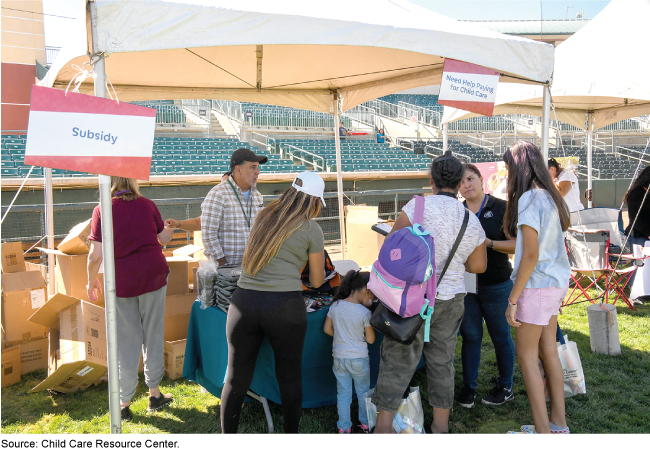Child Care: Observations on States' Use of COVID-19 Pandemic-Related Funding
Fast Facts
During the pandemic, Congress provided more than $52 billion in supplemental funding to help keep child care providers in business and ensure that low-income families could still access care.
In this testimony, we discuss our work on how states used those funds, e.g., waiving family co-payments and increasing payments to care providers. States are still spending the money, and a full picture of its impact may not be available until 2026.
Providers and low-income families face longstanding challenges that require a sustained effort to address. We plan to report in the future on whether and how states used pandemic funding on long-term solutions.
California set up temporary application centers at community events as part of their child care subsidy enrollment outreach during the pandemic.

Highlights
What GAO Found
The Child Care and Development Fund (CCDF) is the largest federal child care program, providing grants to states to improve the affordability, availability, and quality of child care. For fiscal years 2020 and 2021, CCDF was appropriated substantially more than fiscal year 2019 CCDF allocations to help states prevent, prepare for, and respond to the pandemic (see table). Each new funding source came with its own rules and deadlines for states to obligate and spend funds. States were also provided additional programmatic flexibilities.
|
Coronavirus Supplemental Appropriations to the Child Care and Development Fund (CCDF) in Fiscal Years 2020 and 2021 and Total Spending as of April 2023 |
||||
|
Act |
Appropriation to CCDF (billions) |
Estimated total spending as of April 2023 (billions) |
Spending deadline |
|
|---|---|---|---|---|
|
Coronavirus Aid, Relief, and Economic Security (CARES) Act (2020) |
$3.5 |
$3.3 |
Sept. 30, 2023 |
|
|
Coronavirus Response and Relief Supplemental Appropriations Act, 2021 (CRRSA) |
$10.0 |
$8.0 |
Sept. 30, 2023 |
|
|
American Rescue Plan Act of 2021 (ARPA) |
child care stabilization funds |
$24.0 |
$19.9 |
Sept. 30, 2023 |
|
supplemental CCDF funds |
$15.0 |
$3.3 |
Sept. 30, 2024 |
|
|
Total |
$52.5 billion |
$34.5 billion |
||
Source: Pub. L. No. 116-136, div. B, tit. VIII, 134 Stat. 281, 557 (2020); Pub. L. No. 116-260, div. M, 134 Stat. 1182, 1914; and Pub. L. No. 117-2, §§ 2201, 2202, 135 Stat. 4, 31; Department of Health and Human Services (HHS) documents; and GAO interviews with HHS officials. I GAO-23-106833
States used supplemental funding and temporary flexibilities in various ways, but data on the full extent of their use and impact is not yet available. In October 2021, GAO reported that data from its national survey of state CCDF administrators showed states used the funds and flexibilities in 2020 to, for example, help essential workers pay for care and pay care providers based on enrollment, not attendance. According to HHS officials, as of April 2023, states spent an estimated $34.5 billion of the $52.5 billion in supplemental COVID-19 relief funds. Due to states still having time to expend the funds and lags in data reporting, a full accounting will likely not be available until 2025 or 2026.
State child care administrators GAO interviewed in the fall of 2022 said they faced challenges managing supplemental pandemic funding as they adapted to meet the needs of child care providers and families during the pandemic. They reported facing remaining uncertainty about the impact of the funds' expiration on providers and families who may continue to face long-standing challenges like a workforce shortage and a lack of child care supply. Several of the administrators and child care experts GAO interviewed said that provider payment rates often are not sufficient to cover the high cost of providing quality care, leading to fewer providers accepting subsidies and fewer places for families to use them. As such, addressing these and other key challenges would require a sustained effort.
Why GAO Did This Study
The federal government has long invested in child care as a key support for workers to help them become self- sufficient. Child care subsidies funded by CCDF help some low-income families afford child care so parents can work, attend school, or participate in job training. Appropriations for child care through CCDF during the COVID-19 pandemic totaled more than $52 billion. This represented a concerted effort to stabilize the sector and to ensure that low-income families would continue to have access to affordable child care. States were also given new flexibilities in how they administer CCDF programs. These efforts to support child care providers and families are ongoing, as these funds have not yet expired.
This statement is primarily based on GAO's October 2021 and March 2023 reports on CCDF, including child care during the COVID-19 pandemic. It addresses (1) how states used federal COVID-19 relief child care funds and flexibilities, and (2) past and continuing challenges states faced spending these funds.
For our prior work, GAO (1) surveyed state CCDF administrators in 50 states and the District of Columbia and asked about their uses of supplemental child care funds and flexibilities in 2020, and (2) interviewed the state child care administrators in seven selected states—California, Colorado, Connecticut, Georgia, Michigan, New Mexico, and Texas—in September and October 2022. These states were selected to represent varying state program attributes like geographic region and population size.
For more information, contact Kathryn A. Larin at (202) 512-7215 or larink@gao.gov.
